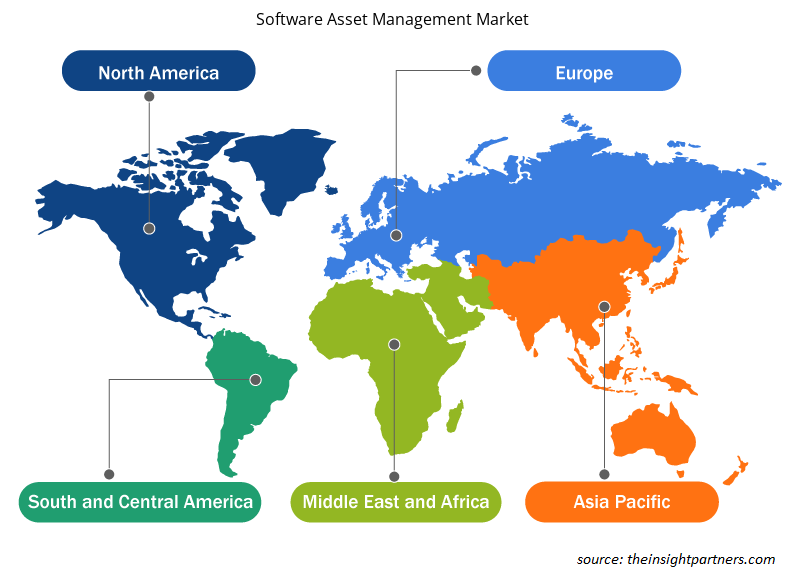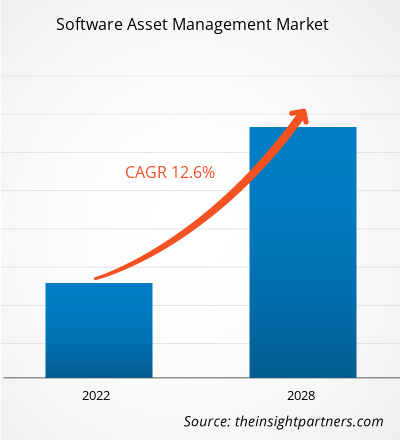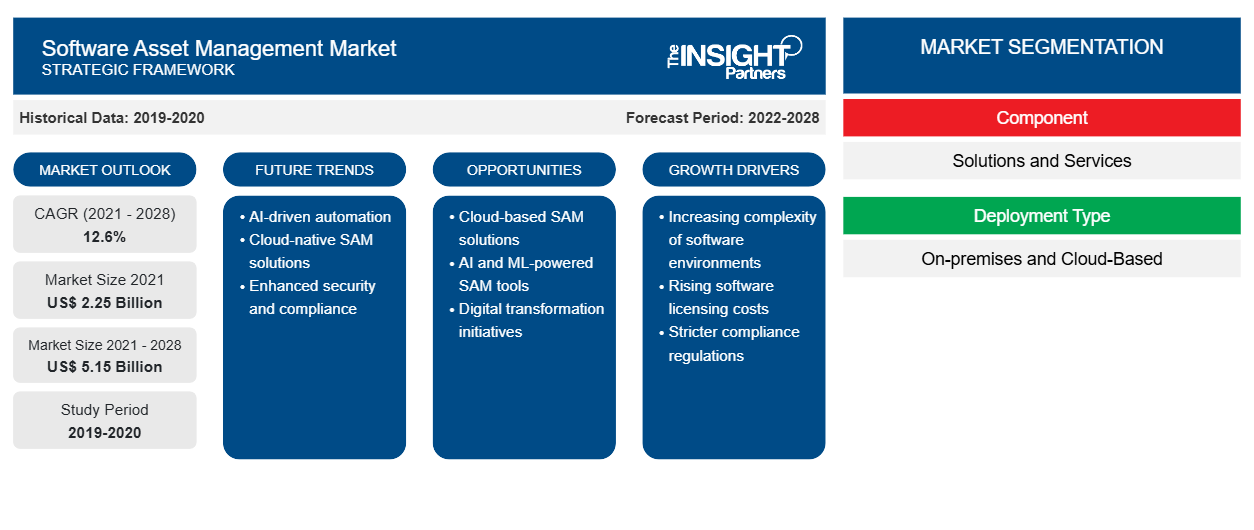[تقرير بحثي] من المتوقع أن ينمو سوق إدارة الأصول البرمجية من 2،250.37 مليون دولار أمريكي في عام 2021 إلى 5،150.51 مليون دولار أمريكي بحلول عام 2028؛ ومن المتوقع أن ينمو بمعدل نمو سنوي مركب قدره 12.6٪ من عام 2021 إلى عام 2028.
تُعرف إدارة الأنظمة والقواعد والإجراءات التي تمكن من الحصول على تطبيقات البرامج وتنفيذها واستخدامها وصيانتها والتخلص منها داخل المؤسسة باسم إدارة الأصول البرمجية (SAM). تُعَد سوق إدارة الأصول البرمجية أحد مكونات إدارة أصول تكنولوجيا المعلومات التي تهدف إلى ضمان التزام الشركة باتفاقيات الترخيص وعدم إنفاقها الزائد على البرامج. إن تحديد الأصول البرمجية، وصلاحية اتفاقيات ترخيص المستخدم النهائي (EULA)، والاستخدام المناسب للبرامج المجانية كلها أهداف أساسية لأي مسعى لإدارة الأصول البرمجية. يمكن أن تحمي وثائق إدارة الأصول البرمجية الشركة من دعاوى مكافحة القرصنة، وتقلل من إساءة استخدام الترخيص غير المقصودة، وتوفر التحكم في البرامج الظلية على الشبكة.
قد تكون إدارة أصول البرامج في منظمة كبيرة معقدة للغاية بحيث تتطلب تطوير وصيانة قاعدة بيانات تحتفظ بالمعلومات حول مشتريات البرامج والاشتراكات والتراخيص والتحديثات. غالبًا ما يكون فريق مثل هذا مسؤولاً عن تجديد تراخيص البرامج والتفاوض على اتفاقيات ترخيص جديدة واكتشاف وإزالة البرامج التي نادرًا ما يتم استخدامها أو لا يتم استخدامها مطلقًا. سيقوم سوق إدارة أصول البرامج بمراجعة عدد تراخيص البرامج المشتراة ومطابقتها مع عدد التراخيص المثبتة لأتمتة كيفية الحصول على المعلومات من العديد من مصادر المخزون المحمولة وسطح المكتب ومركز البيانات والسحابة. قد تتبع أدوات إدارة أصول البرامج أيضًا عدد التراخيص المتبقية. لتقليل النفقات، يمكن استخدام هذه المعرفة لحذف أو إعادة تخصيص البرامج التي لا يتم استخدامها.
قم بتخصيص هذا التقرير ليناسب متطلباتك
ستحصل على تخصيص لأي تقرير - مجانًا - بما في ذلك أجزاء من هذا التقرير، أو تحليل على مستوى الدولة، وحزمة بيانات Excel، بالإضافة إلى الاستفادة من العروض والخصومات الرائعة للشركات الناشئة والجامعات
- احصل على أهم اتجاهات السوق الرئيسية لهذا التقرير.ستتضمن هذه العينة المجانية تحليلاً للبيانات، بدءًا من اتجاهات السوق وحتى التقديرات والتوقعات.
رؤى إقليمية حول سوق إدارة الأصول البرمجية
لقد قام المحللون في Insight Partners بشرح الاتجاهات والعوامل الإقليمية المؤثرة على سوق إدارة الأصول البرمجية طوال فترة التوقعات بشكل شامل. يناقش هذا القسم أيضًا قطاعات سوق إدارة الأصول البرمجية والجغرافيا في جميع أنحاء أمريكا الشمالية وأوروبا ومنطقة آسيا والمحيط الهادئ والشرق الأوسط وأفريقيا وأمريكا الجنوبية والوسطى.

- احصل على البيانات الإقليمية المحددة لسوق إدارة الأصول البرمجية
نطاق تقرير سوق إدارة الأصول البرمجية
| سمة التقرير | تفاصيل |
|---|---|
| حجم السوق في عام 2021 | 2.25 مليار دولار أمريكي |
| حجم السوق بحلول عام 2028 | 5.15 مليار دولار أمريكي |
| معدل النمو السنوي المركب العالمي (2021 - 2028) | 12.6% |
| البيانات التاريخية | 2019-2020 |
| فترة التنبؤ | 2022-2028 |
| القطاعات المغطاة | حسب المكون
|
| المناطق والدول المغطاة | أمريكا الشمالية
|
| قادة السوق وملفات تعريف الشركات الرئيسية |
|
كثافة اللاعبين في سوق إدارة الأصول البرمجية: فهم تأثيرها على ديناميكيات الأعمال
يشهد سوق إدارة الأصول البرمجية نموًا سريعًا، مدفوعًا بالطلب المتزايد من المستخدم النهائي بسبب عوامل مثل تفضيلات المستهلكين المتطورة والتقدم التكنولوجي والوعي المتزايد بفوائد المنتج. ومع ارتفاع الطلب، تعمل الشركات على توسيع عروضها والابتكار لتلبية احتياجات المستهلكين والاستفادة من الاتجاهات الناشئة، مما يؤدي إلى زيادة نمو السوق.
تشير كثافة اللاعبين في السوق إلى توزيع الشركات أو المؤسسات العاملة في سوق أو صناعة معينة. وهي تشير إلى عدد المنافسين (اللاعبين في السوق) الموجودين في مساحة سوق معينة نسبة إلى حجمها أو قيمتها السوقية الإجمالية.
الشركات الرئيسية العاملة في سوق إدارة الأصول البرمجية هي:
- شركة مايكروسوفت
- إيفانتي
- برنامج سنو
- شركة بي إم سي للبرمجيات
- سيرتيرو
إخلاء المسؤولية : الشركات المذكورة أعلاه ليست مرتبة بأي ترتيب معين.

- احصل على نظرة عامة على أهم اللاعبين الرئيسيين في سوق إدارة الأصول البرمجية
سوق إدارة الأصول البرمجية – نبذة عن الشركة
- شركة مايكروسوفت
- إيفانتي
- برنامج سنو
- شركة بي إم سي للبرمجيات
- سيرتيرو
- فليكسيرا
- شركة آي بي إم
- التركيز الدقيق
- الخدمة الآن
- شركة برودكوم
- التحليل التاريخي (سنتان)، سنة الأساس، التوقعات (7 سنوات) مع معدل النمو السنوي المركب
- تحليل PEST و SWOT
- حجم السوق والقيمة / الحجم - عالمي، إقليمي، بلد
- الصناعة والمنافسة
- مجموعة بيانات إكسل
التقارير الحديثة
تقارير ذات صلة
شهادات العملاء
سبب الشراء
- اتخاذ قرارات مدروسة
- فهم ديناميكيات السوق
- تحليل المنافسة
- رؤى العملاء
- توقعات السوق
- تخفيف المخاطر
- التخطيط الاستراتيجي
- مبررات الاستثمار
- تحديد الأسواق الناشئة
- تحسين استراتيجيات التسويق
- تعزيز الكفاءة التشغيلية
- مواكبة التوجهات التنظيمية





















 احصل على عينة مجانية ل - سوق إدارة الأصول البرمجية
احصل على عينة مجانية ل - سوق إدارة الأصول البرمجية